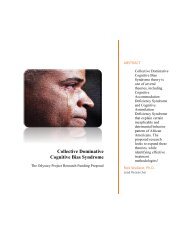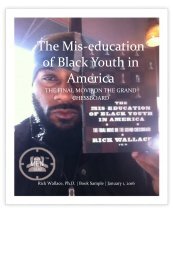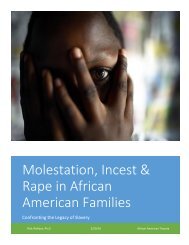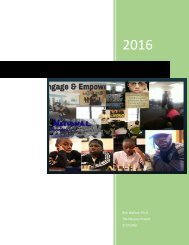Addressing African American Inner-City Violence
Looking at the causality and viable engagement options for effectively dealing with African American inner-city violence, especially as it pertains to African American adolescent males.
Looking at the causality and viable engagement options for effectively dealing with African American inner-city violence, especially as it pertains to African American adolescent males.
You also want an ePaper? Increase the reach of your titles
YUMPU automatically turns print PDFs into web optimized ePapers that Google loves.
2016<br />
<strong>African</strong> <strong>American</strong> <strong>Inner</strong>-city <strong>Violence</strong><br />
Rick Wallace, Ph.D.<br />
The Odyssey Project<br />
6/21/2016
<strong>Addressing</strong> <strong>African</strong> <strong>American</strong> <strong>Inner</strong>-city<br />
<strong>Violence</strong> through Racial Socialization<br />
By<br />
Dr. Rick Wallace, Ph.D.<br />
2016 Copyright © The Odyssey Project Research Department
<strong>Addressing</strong> <strong>African</strong> <strong>American</strong> <strong>Inner</strong>-city <strong>Violence</strong> through Racial Socialization<br />
The multitudinous, enigmatic issues that are plaguing the Black collective have been welldocumented<br />
in books, research, articles and academic papers, and one of the most polarizing<br />
topics is what is commonly referred to by mainstream media as “black on black” crime. While I<br />
have played an integral role in exposing the myth of black on black crime as an exclusive<br />
phenomenon, I must still acknowledge the existence of intraracial hostility and fratricide as a<br />
serious threat to the idea of black empowerment. The fact that the vast majority of violent crimes<br />
against blacks are committed by other blacks is nothing unusual. It is a natural part of the social<br />
construct. People normally commit violent acts against those they are most exposed to within<br />
their enclave. In fact, 84 percent of homicides against Whites are committed by other whites, and<br />
this number is pretty consistent throughout all racial makeups.<br />
Support the inner-city work of The Odyssey Project!<br />
Yet, the problem still remains that Blacks, especially adolescents and young adults are killing<br />
each other at an alarming rate. With the Black male population suffering a major hit from mass
incarceration, we cannot afford the perpetual occurrence of young black males killing one<br />
another — not to mention innocent bystanders.<br />
I have invested a substantial amount of time in understanding the causality of the violence in the<br />
inner city. What I have found is that there are a number of primary elements involved. At the<br />
core, there are common influencers, such as being the victim of violence, witnessing violence,<br />
and urban hassle. Each of these influencers serve to increase the proclivity of <strong>African</strong> <strong>American</strong><br />
adolescent males to become violent. However, there are two elements that are viewed as the<br />
most prevalent influencers — the feeling of being disrespected and the lack of proper racial<br />
socialization (DeGruy, Brennan, & Briggs, 2009). While the manner in which “respect”<br />
influences the development of a prosocial attitude in <strong>African</strong> <strong>American</strong> youth is immensely<br />
important, and most likely the most powerful influence in the increased risk of violence, it is the<br />
development of a universal racial socialization process, introduced through a “rite of passage”<br />
model, that will have the greatest initial impact.<br />
Get your signed copy of The Mis-education of Black Youth in America!<br />
Racial socialization is defined as specific verbal and non-verbal messages that are transmitted to<br />
younger generations for the development of values, attitudes, behaviors, and beliefs regarding<br />
the meaning and significance of race and racial stratification, intergroup interactions, and<br />
personal and group identity.<br />
Racial socialization is receiving increased attention in the world of scientific research, primarily<br />
due to the fact that there is growing empirical and pragmatic evidence to support the idea that it<br />
is a protective developmental process, especially when it comes to <strong>African</strong> <strong>American</strong> families.<br />
Not only can proper rational socialization of <strong>African</strong> <strong>American</strong> males reduce the need to
discipline children, it can also increase the effect of disciplinary action, when it is deemed<br />
necessary (Rodriguez, McKay, & Bannon, 2009).<br />
While racial socialization can enhance the ability of Blacks to effectively parent their children, it<br />
has the capacity to do so much more. Proper racial socialization can prepare children to adjust to<br />
the unique demands associated with being black — helping them develop a positive self-concept.<br />
Additionally, when <strong>African</strong> <strong>American</strong> children are faced with discrimination and racism, they<br />
will have the ability to identify with the prosocial attitude and pride of belonging to the Black<br />
race, using this identity as a coping strategy (Boykin & Toms, 1985; Peters, 1985; Ward, 2000).<br />
Theory and research on racial socialization as a part of the parenting process in managing the<br />
behavior of children, and studies focused on behavioral problems have developed separately;<br />
however, recent research has gravitated towards examining how certain aspects of racial<br />
socialization relate to impacting problem behaviors, including violence (Caughy, O'Camp,<br />
Randolf, & Nickerson, 2002; Stenvenson, Herrero-Taylor, Cameron, & Davis, 2002)<br />
Racial socialization is the primary vehicle of cultural transmission for <strong>African</strong> <strong>American</strong> families<br />
that are steeped in the tradition of oppressive resistance — involving actions and conversations<br />
that communicate to our children how to survive and thrive with dignity, despite the incessant<br />
hostility by those in their periphery (Stevenson, Davis, & Abdul-Kabir, 2001).<br />
One thing that we have done as a racial group that has limited our effectiveness in preparing our<br />
children, is that we fail to see beyond the surface of the symptomatic issues that plague our<br />
communities. Additionally, we fail to see education as a tool of empowerment. We see the<br />
violence, the dropout rates and higher incarceration rates, but it has become easier for us to<br />
accept the narrative provided to us by the mainstream media than it is to examine them for<br />
ourselves, and to develop solutions that will prove efficacious in achieving the progressive goals<br />
we set. The answers are there, but we cannot holistically address the problem by only seeing the<br />
symptoms.<br />
In essence, the violence that we are experiencing at record levels within our communities are the<br />
results of our failure to properly socialize and educate our children. We have not prepared them<br />
to go out and compete in a world that is innately hostile toward them. We have not created<br />
systems that provide the support necessary for them to thrive without acquiescing to the demands<br />
of those who operate in a dynamic that is antithetical to their survival and success.<br />
It is time that we invest ourselves in effectively engaging our problems, not on the surface, but at<br />
the origin. ~ Dr. Rick Wallace, Ph.D.<br />
Bibliography<br />
Boykin, A., & Toms, F. (1985). Black Child Socialization: A Conceptual Framework. Thousand<br />
Oaks, CA: Sage Publications.
Caughy, M., O'Camp, P., Randolf, S., & Nickerson, K. (2002). The Influence of Raical<br />
Socialization Practices on the Cognitive and Behavioral Competence of <strong>African</strong><br />
<strong>American</strong> Preschoolers. Journal of Child Development.<br />
DeGruy, J., Brennan, E. M., & Briggs, H. E. (2009). The <strong>African</strong> <strong>American</strong> Adolescence<br />
Respect Scale: The Measure of Prosocial Attitude. The University of Portland, 1-3.<br />
Peters, M. (1985). Ethnic Socialization of Young Black Children. Beverly Hills, CA: Sage<br />
Publications.<br />
Rodriguez, J., McKay, M. M., & Bannon, W. M. (2009). The Role of Racial Socialization in<br />
Relation to Parenting Practices and Youth Behavior: An Exploratory Analysis. National<br />
Institute of Health.<br />
Stenvenson, H., Herrero-Taylor, T., Cameron, R., & Davis, G. (2002). Mitigating Instigation:<br />
Cultural Phenomenological Influences of Anger and Fighting Among "Big-Boned" and<br />
"Baby-faced" <strong>African</strong> <strong>American</strong> Youth. Journal of Youth and Adolescence.<br />
Stevenson, H., Davis, G., & Abdul-Kabir, S. (2001). Stickin to, Watchin Over and Gettin With:<br />
An <strong>African</strong> <strong>American</strong> Parent's Guide to Discipline. San Francisco: Josey-Bass.<br />
Ward, J. (2000). The Skin We're In: Teaching Our Teens to be Emotionally Strong, Socially<br />
Smart and Spiritually Connected. New York: Simon and Schuster.

















